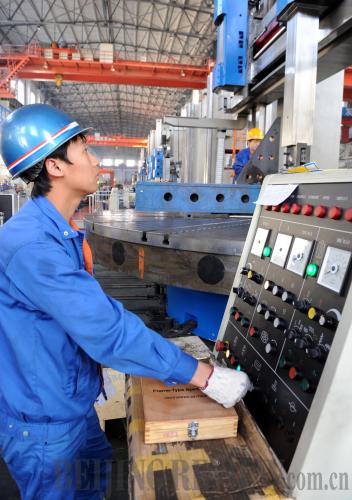|
 |
|
CENTRAL STRENGTH: A worker at Qier Machine Tool Group Co. Ltd., a central SOE in Heilongjiang Province that produces machine tools, operates a control board (LI YONG) |
China has taken one more step on its path to reforming centrally administered state-owned enterprises (SOEs). The State-owned Assets Supervision and Administration Commission of the State Council (SASAC) has launched pilot reforms for two companies—Grirem Advanced Materials Co. Ltd. and Space Star Technology Co. Ltd.—requiring them to distribute dividends to employees annually, said Shao Ning, SASAC Vice Chairman. Moreover, the two companies have mapped out their own detailed measures on dividend incentives.
This is the first time China's central SOEs has handed out dividends to their employees, a signal that the SASAC is gearing up to restructure the income distribution system of central SOEs.
The SASAC performs investor's responsibilities, and supervises and manages the central SOEs. Since its founding in 2003, the SASAC has pushed forward a series of reforms to heighten management efficiency of the central SOEs.
Despite these efforts, the central SOEs still face a number of obstacles, such as outdated systems or mechanisms and weak competitiveness. Shao said the dividend incentive can be a needed boon to remove the system barriers impeding the development of the central SOEs.
Under the pilot program, the SASAC required the dividend incentive to only be offered to certain positions.
"Only those who performed well on the designated positions can receive dividends and benefit from the enterprise's growth," said Shao.
The reform is expected to provide a powerful catalyst for employees to compete for positions and improve their performances, he said.
While they formulate reform measures, the enterprises are required to clearly define the responsibilities of the positions, and put in place an effective employee performance evaluation system.
Hi-tech start
Since October 2010, seven central SOEs have applied to participate in the pilot dividend incentive program. Grirem and Space Star were the only ones selected, making it obvious the SASAC wants to start the reform with hi-tech firms.
China's hi-tech central SOEs, most of which were formerly research institutions, have continued their previous rigid institution systems in which employees' compensation is largely decoupled from their contributions. For example, Space Star used to be a research institution of the China Aerospace Science and Technology Corp. engaged in satellite application research. Grirem was transformed from a rare earth research center of the Beijing General Research Institute for Non-ferrous Metals.
As a result, the government is desperate to lift the obstacles undermining the prospects of hi-tech companies. The SASAC appointed China International Intellectech Corp., a professional consulting firm, to help accelerate the reform process.
Both the two companies have favored technology positions in terms of dividend allocation. Scientific research positions of the two firms account for more than 90 percent of their jobs eligible for dividends, as well as the total amount of annual dividends. The other designated positions are also closely connected to scientific research applications.
The difference is Space Star plans to allocate a certain proportion of its annual added value as dividends while Grirem links dividends with annual net profits.
| 